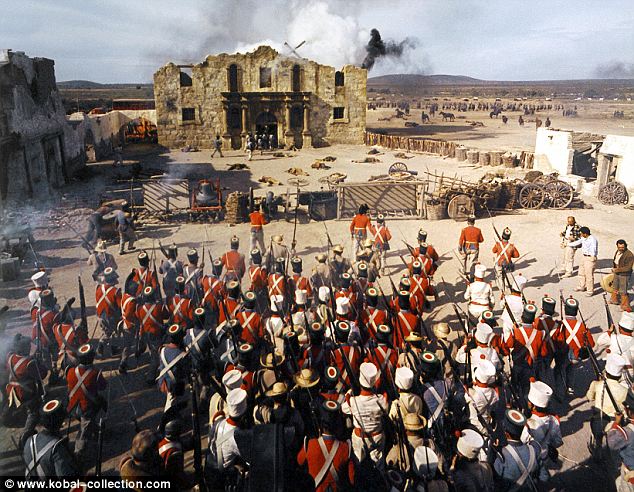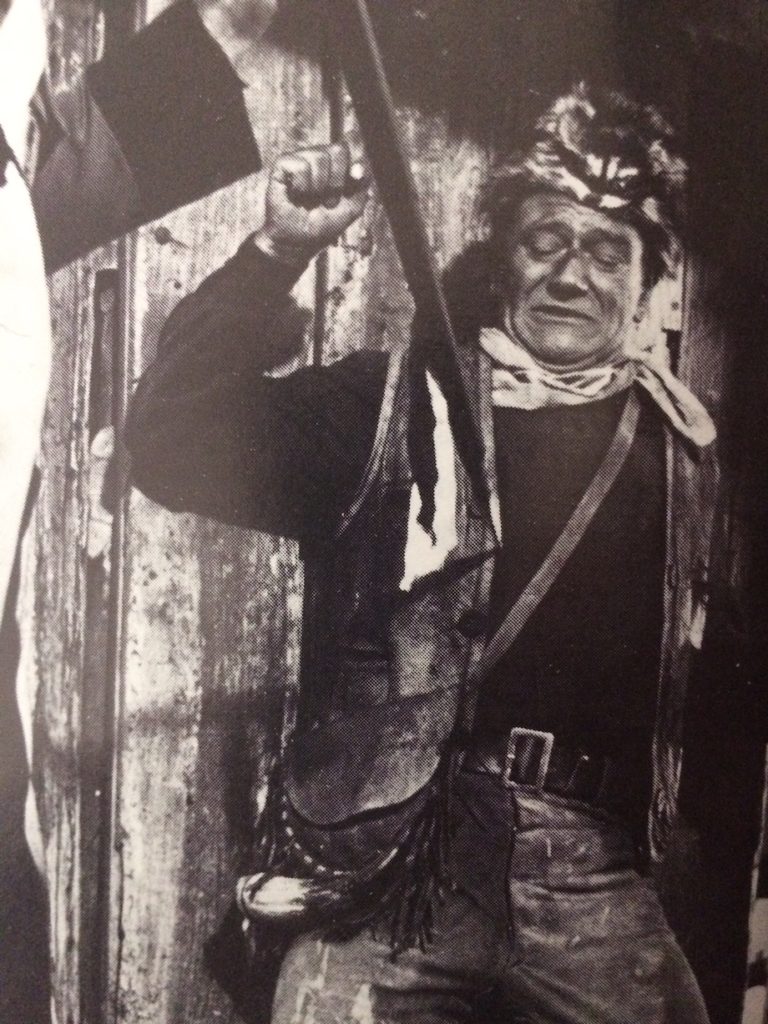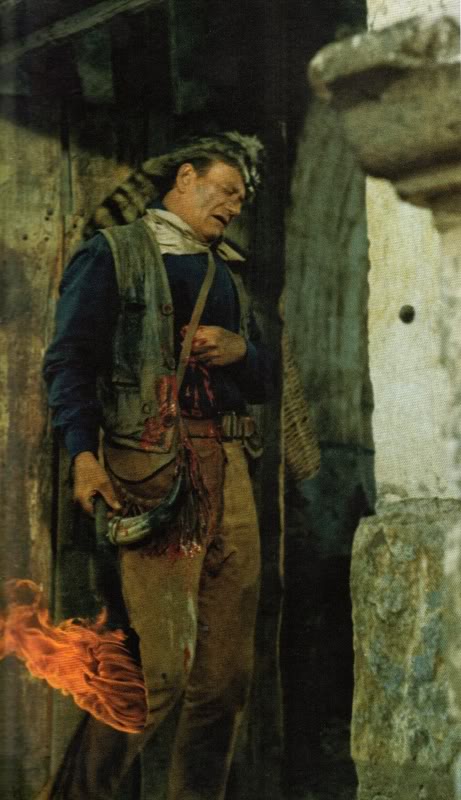It’s ten minutes into the final assault in “The Alamo”, and Dimitri Tiomkin’s superlative score heralds the beginning of the end for Davy Crockett.

He makes his way towards the door of the mission, torch in hand, rifle in the other, turning as he runs and throwing the weapon in the face of an advancing Mexican soldier. He hits the door, pushes his torch into the face of another soldier and, thus distracted, fails to counter another who runs him through with a lance, piercing our hero in his right chest.
Crockett emits a cry of pain as the lance goes right through him and literally pins him to the door. As copious amounts of blood run down his shirt and trouser leg he pushes the enemy soldier away with the torch, snaps the lance with a twist of his body then staggers away towards the powder room, the bloodied lance head embedded in the door behind him.
Crockett’s final act is to throw the still lit torch into the magazine, helpfully sign-posted with the word ‘Magazine’ written in white paint on the right-hand side of the doorway. He stumbles through the door, the torch lands amidst a bunch of powder kegs and up goes the Alamo and Crockett with it.
It is without doubt one of the most memorable John Wayne death scene of all, second only to his demise at the hands of Bruce Dern in “The Cowboys”.
However, let’s rewind right back to the beginning of the scene because, according to some of the people who worked on the film, things weren’t exactly as straightforward as they seem to appear on the screen.
In the John Farkis book on the making of the film, “Not Thinkin’…Just Rememberin’”, or, as I’ve decided to call it, “Everything You Always Wanted to Know About ‘The Alamo’ But Were Afraid to Ask”, the author suggests there were a number of rehearsals and two actual takes made for the film.

The image above shows what I think must have been one of the rehearsals as Wayne does not appear to be holding a torch in his right hand. On further examination of the image, you’ll see there’s bleach on the trousers so this rehearsal must have taken place after the first take.
On the first take, stuntman Bob Morgan went to stab Wayne in the chest using a lance with a retractable blade and promptly tripped over and nearly knocked himself out.
Farkis has obviously watched the documentary on the making of the film which was originally released with the roadshow version of “The Alamo” on laserdisc, as he quotes John Jensen, who witnessed the incident, word for word.
Jensen relates that Wayne, realising Morgan was down, started shouting “Stick me, stick me, stick me dammit, stick me!” to all and sundry on the set. Farkis suggests, rightly in my opinion, that this is a “somewhat apocryphal story of the first take” as this supposes that there was a backup stunt man present, with a retractable lance, ready to take Morgan’s place in the event of an incident such as this.
Either way, the first take was found to be unsatisfactory so they set up for a subsequent take. Wayne held a blood squib in his left hand which he detonated as he pushed the lancer away with his right, the liquid then staining his costume accordingly.
Before going for the next take the blood was washed from Wayne’s costume with bleach which explains the white stain on the right leg of his trousers.

Farkis worked out that the finished scene is a combination of cuts from two takes. He identifies this by pointing out that at one point there is a pennant on the lance as Bob Morgan approaches Wayne. The pennant is not there in the close shot of the lance penetrating Wayne’s chest.
Jensen continues his story in the documentary with a description as to what happened when they shot Wayne’s final scene in which he blows up the magazine, as follows:
“He (Wayne) throws his torch through the Alamo, it hits these big lights and the torch lands just where these guys were putting in the dynamite charges (for the scene in which Crockett blows up the powder room)”. Again, probably apocryphal but I guess we’ll never know, although I find it hard to believe the crew would be attempting to shoot a major scene whilst live dynamite was being prepped a torch throw away.
One thing I always find amusing whenever I watch Wayne’s death scene in “The Alamo” is that when he runs towards the door you can see quite clearly a couple of extras dressed as Mexican soldiers leaning against a post inside the mission as if nothing is going on around them. I also like the the extended sequence in the roadshow version when Wayne yanks himself away from the door, disappears then staggers back for one last bow before wandering off to the magazine towards death, glory and a guaranteed place in the psyche of every John Wayne fan when they saw the film for the first time.
As an aside, I always thought that blowing up the magazine was rather a selfish act on Crockett’s behalf as the explosion probably took out a few of the other defenders at the same time. On the other hand, there are worse ways of putting an ‘Amen’ to it.
So, with regards to the title of this article, I suggest the answer is “numerous times” or maybe “more than once” if you consider it took a few rehearsals and two filmed takes in order to get it right.
For many of his fans, Wayne’s death scene has achieved iconic status over the years. Pete Townsend, guitarist with the British beat combo The Who, was quoted a long time ago as saying how much he loved the fact that he could watch John Wayne dying over and over again as many times as he wanted to on his brand new video player.
As I think I might have written before I’m not sure he meant that in a good way but if you feel like watching it again yourselves and you don’t want to go to the trouble of finding it on your DVD then here it is.
Enjoy isn’t probably the right word. Then again, it’s only a film, but a pretty good one at that.
